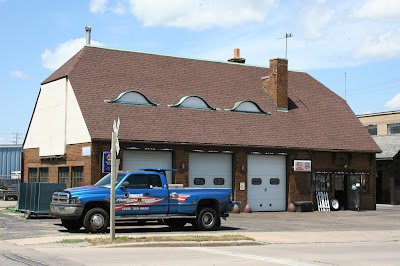location of Syme's flour mill on Fox River at #2
from Volume II of P.V. Lawson's History, Winnebago County, Wisconsin : Its Cities, Towns, Resources, People (1908):
Flour mills were a part of Menasha from its very beginnings. Lawson's history states:
"The finest flouring mill ever erected in the Fox River Valley was the Eagle mill, a four-story brick structure, erected on the site of the first grist mill in Menasha, on the north end of the dam. The firm was composed of Mr. Alexander Syme who came to Menasha March 24, 1855; Mr. William P. Rounds, who came in 1850; Mr. Charles May, who came in 1850; Mr. Henry Hewitt, Sr., who came in 1856. The partnership was organized in 1867 under the firm name of W. P. Rounds & Co. The foundation was put in in the fall and the mill completed in 1868. It had a capacity of 400 barrels of flour daily and ran night and day. The mill was originally supplied with six run of stone and all the necessary separating and cleaning machinery. In July, 1877, Mr. Alexander Syme bought the interest of his partners. He soon after erected on the railroad sidetrack as an addition to the mill a three-story brick elevator. The roller mill system had become generally understood and necessary for the equipment of all flour mills by 1880, and Mr. Syme at that time had three sets of patent roller mills set up in his mill and the introduction of new machinery was then made as rapidly as found necessary. The mill was operated with great success and making $20,000 annual profits, when the unheard of high water roused the riparian occupants along the lake and river to appeal to Congress to enlarge the openings in the dam. The officer under the engineer service of the War Department commenced work to remove the solid embankment between the Eagle mill and the Coral mill, both then owned by Mr. Syme. The intention was to open a water spill over the north end of the dam. The lots below the Eagle mill had been built up by railroad track and the Menasha Chair Company's buildings and filling of the lots so far out into the stream that the tail race of the Eagle mill was extended to a line with the Coral mill, and if the water was poured over this solid part of the dam the back water would be so high on the water wheels that ran the mill as to cut down their power to a point where his mill could not run. He was obliged to enjoin further work by the United States engineer and stop the removal of the embankment. Proceedings were then taken by the assistant United States attorney, Mr. M. A. Thomas, to condemn the whole property in both mills, estimated to be worth $70,000. The mills were paid for and removed in 1885 by the engineers of the United States and the dam extended, and afterward in 1886 a new dam built all across the river."
Thus ended the flouring era in Menasha. The industry lasted a bit longer in Neenah but by the 1890's, the flour industry was all but over, having been topped by the profitability of paper manufacture. Neenah's last flour mill closed in 1908.
Of Mr. Syme specifically, Lawson said:
"Mr. Alexander Syme was a handsome man, a splendid fellow and enterprising. He was interested in a stave factory, a pail factory, a bank and a number of other enterprises. As a miller he was regarded as among the best. His flour had a ready sale among the great bakeries and no one could take his customers from him. He had a method of mixing spring and winter wheat or the soft Wisconsin with the hard Dakota wheat, that made a flour unequaled for bakers' bread, as it was not easily dried up and hardened. It would keep in good condition several days longer than other makes of flour. His mill made money fast. When he built his handsome brick residence on Forest Avenue, now owned by Mr. William M. Gilbert, he remarked "that the mill would make the money for the home as fast as required for the building." When his splendid property was torn down by the engineers he lost his courage and did not build another. For several years he traveled abroad and died in France in 1900."

















































